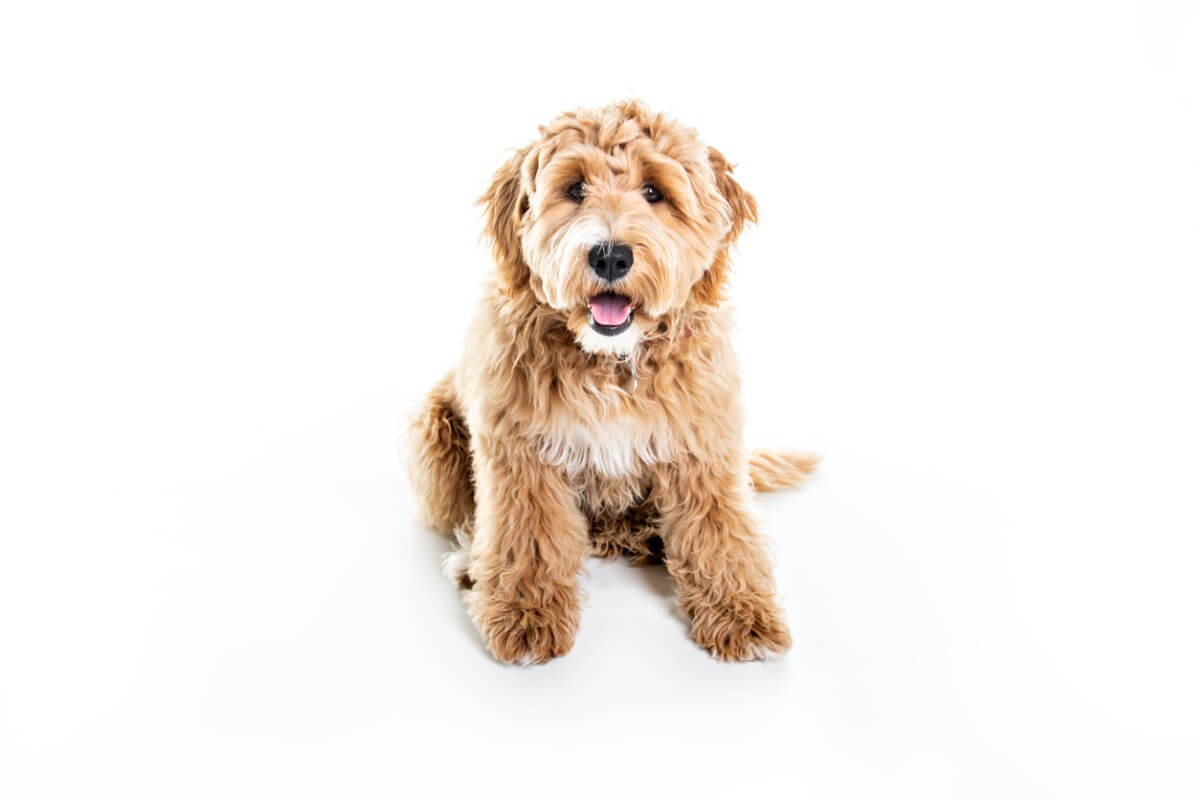Goldendoodle: All About this Breed

Although it isn’t considered an official breed, the Goldendoodle, also known as the Groodle in Australia, is one of the crossbreeds that’s gaining most popularity in homes in the United States and Australia, mainly. Its main attraction is its mix of intelligence and friendliness, traits that come from its original breeds.
Do you want to know more about this hybrid between the poodle and the Golden Retriever? Here you can find out all about the origin of this breed, as well as its general temperament and the care it requires. Don’t miss it.
Origin of the Goldendoodle
Breeders began marketing these animals in the 1990s. They were looking for a breed similar to the Labradoodle (a cross between a Labrador and a poodle), but with less hair loss. The poodle is known for shedding very little fur, a favorable situation for people with allergies.
Thus, the Goldendoodle brings together all the intellectual abilities of the Golden Retriever, in addition to its affable character, with the addition of the little hair loss of the poodle. In addition, its appearance is very curious and many people consider it adorable because of the characteristics we’ll tell you about in the following section.

Characteristics of the Goldendoodle
The weight and height of a Goldendoodle depend largely on their ancestry, as the poodle varies more in this regard than the Golden Retriever. The same situation occurs with their coat colors, as the poodle can come in different shades that will determine, to a greater extent, the coat of their offspring, while the Golden Retriever always has a characteristic golden color.
The life expectancy of the Goldendoodle is from 12 to 15 years.
A curious fact about these dogs is that their puppies have smooth and straight hair, similar to the Golden retriever, but it curls as it grows, becoming wavy or producing ringlets. They have two layers of hair, with a shorter undercoat to protect them from the cold.
Females are much smaller than males, with an average difference of 5 centimeters (2 inches) in height between the sexes. As adults, Goldendoodles are slender dogs, with elongated limbs, a short tail, and a long thin head.
Temperament
This breed is famous for its balanced, sociable, affectionate, and very sweet character. It can coexist perfectly with other species, including humans (as it gets along well with children). As it’s a dog that will hardly ever reject anyone, and one which forms a very strong bond with its guardian, it shouldn’t be left alone for long periods of time.
The Goldendoodle is an active and intelligent dog. It enjoys long walks, sports and games, both with toys and with his guardians. In addition, he learns tricks and new activities with amazing ease.
Special care
As well as receiving great advantages from the poodle and Golden Retriever, the Goldendoodle also inherits certain special needs. The most important of these are listed below:
- Diet: They’re prone to gluttony and obesity. They should eat quality dry food in portions according to their ideal weight.
- Exercise: The Goldendoodle requires several walks a day, as well as the inclusion of very active games. It’s an ideal dog for athletes and people who like outings in nature and long walks. Agility is also a good option.
- Haircare: Its hair also needs special attention, because the double layer and curls are synonymous with tangles. It should be brushed at least once a day to avoid the formation of knots.
- Bathing: The Goldendoodle can have a bath more or less every month, depending on its activity and the area it walks in (for example, in the open country, where it’ll get dirtier).
- Psychological needs: As mentioned above, the Goldendoodle is a sociable and attached dog. It can’t be left alone all day, as this will run the risk of separation anxiety. In addition, its high activity and intelligence make environmental enrichment necessary to prevent it from getting bored.
Goldendoodle health
These crossbreeds are susceptible to the same health problems as their ancestors. The most typical problems that you’ll find in these dogs are:
- Hip dysplasia: This mainly affects large Goldendoodles. In this pathology, the head of the femur comes out of the acetabulum, the hollow that collects it to form the hip joint. This condition originates in Golden retrievers.
- Von Willerbrand’s disease: In this disease, the clotting factor VII fails, thus affecting the way platelets bind together to heal a wound.
- Eye problems: As with the previous disease, eye problems are inherited directly from poodles. Some of the most typical diseases that can be found in the Goldendoodle are cataracts, progressive retinal atrophy, or glaucoma.
- Atopic dermatitis: This isn’t very common if the animal’s coat is kept in good condition.
- Convulsions and epilepsy.
- Patella luxation.
- Otitis: The large amount of hair in their ears and their love of swimming can cause ear infections in these dogs.

If you want to adopt one of these dogs, then make sure you meet all the necessary conditions to give it a good home and quality of life. It goes without saying that the Goldendoodle will certainly give you a good life, and you’ll find that its wonderful character and endless energy will fill your day-to-day life with truly memorable moments.
All cited sources were thoroughly reviewed by our team to ensure their quality, reliability, currency, and validity. The bibliography of this article was considered reliable and of academic or scientific accuracy.
- Shouldice, V. L., Edwards, A. M., Serpell, J. A., Niel, L., & Robinson, J. A. B. (2019). Expression of behavioural traits in Goldendoodles and Labradoodles. Animals, 9(12), 1162.
- Sadler, J. E. (1994). A revised classification of von Willebrand disease. Thrombosis and haemostasis, 71(04), 520-525.